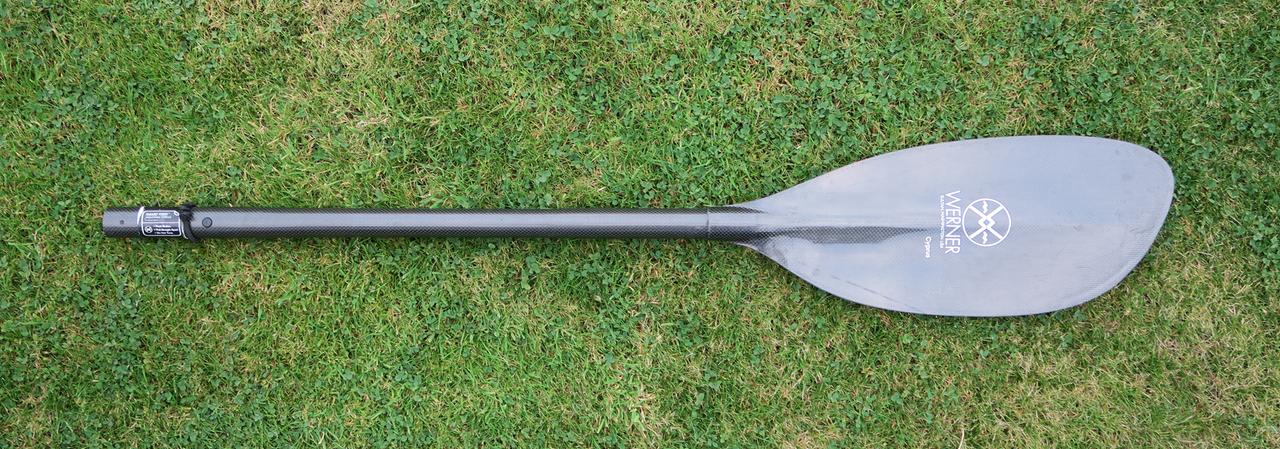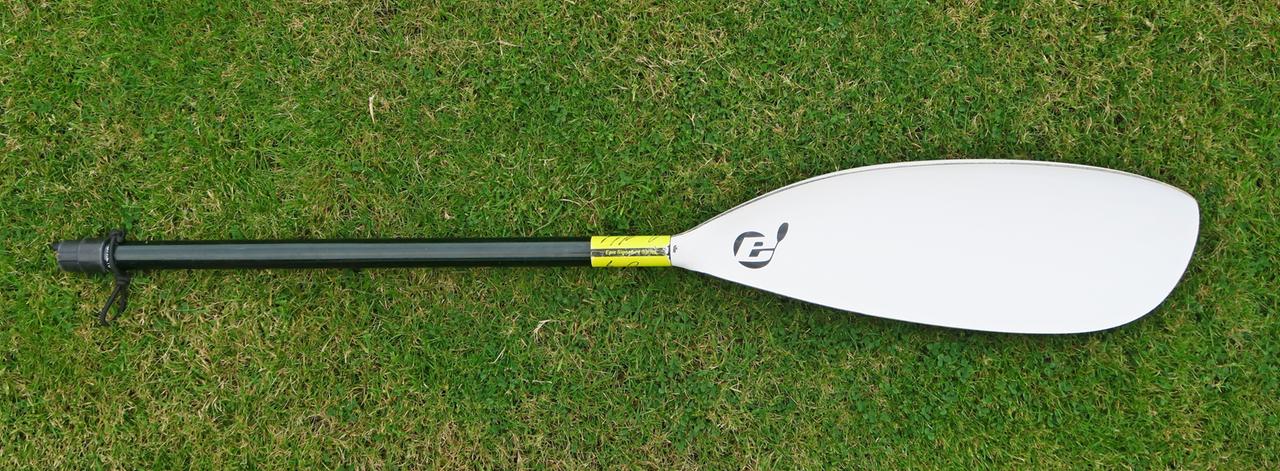Home >
Sea Kayaking >
Kit
Paddles & paddling styles
I have three paddles for sea kayaking; a Euro, a Wing and a Greenland.
Greenland Paddle (GP)
Recently I got a new sea kayak and on the maiden voyage I took all three paddles with the intention of using each one at different stages of the trip. Conditions were fairly benign, there was little wind but with some relatively long period swell left over from the previous days strong winds. I started with the GP as I hadn’t used it for a while. Aficionados of the GP say it’s easier on your joints and is good for long distance touring.


I made my GP in 2006 from a good piece of Western Red Cedar. The ends have a thin layer of fibre glass to protect the end grain. It's 2290mm (7'6ins) long, weighs 1060grams (2lbs 5oz) and 36-38mm (1.4-1.5in) diameter on the loom.
The catch
The catch is especially important with the GP; the angle at which the blade enters the water makes a big difference. If it's at right angles to your arm, the chances are that air will get sucked down behind the blade (ventilation), and this will result in an inefficient stroke. By rotating the top of the blade forward slightly, the blade should slice into the water rather than bash into it. The negative effect is that the blade tends to dive as you pull back, which is something the paddler needs to counteract.
The pull
Anyone new to a GP will find that it flutters easily on the main part of the stroke. After ten minutes or so you'll adapt and it shouldn't be an ongoing issue. Compared to other paddles, the pull doesn't feel as solid in the water. Normally you’d use a low angle paddling style but you can use a high angle style, drawing it away from the kayak as you pull back and slicing it through the water like a wing paddle.
The exit
The exit is typically clean compared to other paddles with only a little water being thrown up by the blade. If a low angle style is used, the exit tends to be slightly past the hip. If a high angle style is used, the exit can be at the hip and the flex in a wooden blade can provide a satisfying 'springy' feel to the exit.
Features
- Different paddle strokes can be easily converted from one to another due to the predictable nature of the paddle in the water
- Excellent for all types of rolling, sculling and sweep strokes as the whole length of the paddle can be used
- Zero feather
- Not so good for 'dynamic' paddling
- Buoyant, and can be used as a stabiliser at rest
- Versatile but predominantly used in a low angle paddling style
- My GP is one piece, so not as easy to store on the kayak
Euro Paddle (EP)
On the recent trip mentioned above, I changed to the EP on the return section. The main differences between the paddles become instantly apparent. The first obvious difference was the solid contact the paddle made with the water. The second was that I was making a cleaner catch than usual due to the fresh memory of the catch in the GP stroke.


It's a Werner Cyprus, straight shaft in full carbon construction. It's 2100mm (6'10.5in) long, weighs 655grams (1lbs 7oz) and 28-31mm (1.1-1.2in) diameter on the loom.
The catch
The angle of entry is not so critical but if one starts pulling before the paddle is submerged it's easy to suck air down behind the blade. It's best to start the catch well forward, and close in to the kayak.
The pull
One can pull hard and paddle in a more 'dynamic' style (see later) than the GP. EPs come in many different shapes and some are more prone to flutter than others but it will be a combination of the paddle shape and the paddler's input that may result in flutter. Generally there will be less chance of flutter than with the GP. The Wing paddle stroke can be used with a EP (see next).
The exit
The exit is typically not as clean as the GP, with some water being thrown up by the blade. It's advisable to exit at the hip and not past it.
Features
- Versatile; low or high angle styles can be used
- Paddle strokes can be converted from one into another but if an element of feather is used it's possible to get caught out in transitions from one side of the kayak to the other
- Adjustable feather
- Good for 'dynamic' paddling
- My EP is very lightweight and I find that to be an excellent feature
Wing Paddle (WP)
Wing paddles enable the highest performance and that's why kayak racers and surf skiers use them. I didn't get the chance to use the WPs on my recent trip but usually take them along with the EPs.


It's an Epic Mid Wing, straight shaft in hybrid construction. It's 2100-2200mm (6'10.5in-7'2in) long, weighs 765grams (1lbs 11oz) and 28-31mm (1.1-1.2in) diameter on the loom.
The catch
One of the most noticeable differences is that you can get away with a hard catch and it will grip instantly, with little chance of air getting sucked down the back of the blade. However, that's not advisable, normally the catch should involve the complete immersion of the blade before the pull begins. As with the EP, catch well forward, close into the kayak and with a high angle style.
The pull
The WP forces the paddler to use body rotation and the core trunk muscles by moving the blade out and away from the kayak as it's pulled back. If you try to paddle in a low angle style and next to the kayak it's likely that the blade will rotate in your hand and dive under throwing you off balance. If you're new to WPs I'd suggest a good exercise is to keep you arms locked solid in a straight line throughout the stroke. This will force you to rotate your upper body. In doing so you should also rotate in the seat and push against the footrest with each leg in turn. This is easier in the open cockpit of a surf ski but not so easy in a sea kayak where you're more constrained. There are many good videos on the internet; search for 'kayak forward paddling technique'. Ivan Lawler has created some detailed videos also under 'Ultimate Kayaks'. The following link is a video which clearly demonstrates body rotation, pumping with the legs and drawing the blade away from the kayak during the pull:
Ski Paddling Technique
The exit
The exit is typically not as clean as the EP or GP with a considerable amount of water being thrown up by the blade. This is due to the spoon shape but could also be due to intermediate technique on my part. It's advisable to exit at the hip and not past it.
Features
- Maximum acceleration and speed. It feels like you are pulling on solid ground
- The high angle style can be tiring over a long distance
- Adjustable feather
- Good for 'dynamic' paddling
- Great for forward paddling but not so easy for other strokes
Conclusions
- Greenland paddle best for rolling, sculling, pottering, playing
- Euro paddle ideal for all round use
- Wing paddle best for speed, acceleration and straight lining
It's good to cycle between all three types of paddle and choose the most suitable one for the conditions and the purpose of the paddling session. Each paddle helps improve technique in different ways. Originally I used feather angles on Euro paddles but over the years reduced this incrementally down to zero. I briefly tried a cranked shaft but prefer the simplicity of straight paddle shafts. I don't have joint issues with any of the paddles. I believe a light weight paddle on the smaller side provides more enjoyment and endurance. A lightweight full carbon GP with a smaller loom diameter could provide a better experience compared with my somewhat heavy GP. An opportunity to paddle a surf ski should not be missed, it's an education in forward paddling technique.
Paddling styles
Pottering
For want of a better term, this is referring to how one might paddle when one is more focused on chatting or sight seeing than on paddling technique. The style tends to be a constant rhythm irrespective of the underlying movement of the sea.
Dynamic
When focused on one's paddling technique (easier when paddling solo), this is all about varying one's paddling cadence and the amount of pull in every stroke according to the underlying movement of the sea. There can be more than one swell from different directions and by feeling the water one can take advantage of the sea state to gain more speed and efficiency. It can be thought of as 'paddling downhill', ie when the nose of the kayak dips, pull harder, when it rises back off.
Home >
Sea Kayaking >
Kit
© Jules Kayak 2024, last updated: April 2024





